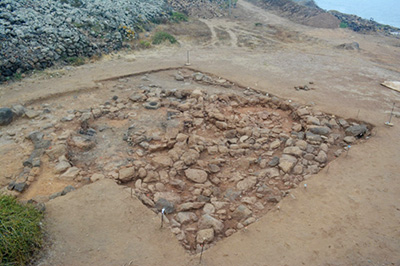Mursia (Island of Pantelleria, Trapani, Sicily)
The Bronze Age village at Mursia

Archaeological mission coordinator/director
Maurizio Cattani
Research Area and ERC Panels
- Archaeology from pre and proto history to medieval age
- SH6 The Study of the Human Past: Archaeology and history”
Starting date of the campaign and duration
The fieldwork project at Pantelleria began in 1996. The excavation at the site of Mursia started in 2001 and are led every year between mid-June and mid-July.
Overview
As a continuation of the project “Archaeological Map of Pantelleria Island”, the Cluster of Archaeology at the Department of History and Civilization of the University of Bologna participated to the excavation of Mursia, in collaboration with the Soprintendenza per i Beni Culturali e Ambientali di Trapani and the University of Napoli “Suor Orsola Benincasa”.
The archaeological context of Mursia is unique in the Bronze Age Mediterranean for the preserved monumentality of the settlement structures and of the near tombs, namely the large tumuli made with volcanic stone slabs, locally called “Sesi”.
The protohistoric village is located in a strategic position on the top of a promontory, 30 m above the sea level, in the north-western part coast of the Isle of Pantelleria. The site spans from the final phases Early Bronze Age (1750 BC) to the Middle Bronze Age 2 (1450 BC) in Italian chronology, which corresponds to the advanced phases of the Sicilian Early Bronze Age.
Material culture can be ascribed to the culture of Rodì-Tindari-Vallelunga (RTV), widely spread in Northern and Western Sicily and characterized by a typical ceramic made with a brown-greyish impasto and sometimes decorated with incisions.
The team directed by Prof. Maurizio Cattani leads the research of the sectors B, C, E, F of the Bronze Age village, which include the monumental fortification (“Muro Alto”) of exceptional dimension (210 m in length; 9 m in height; and 6 m in width).
In particular, the excavation of the sector B has brought to the reconstruction of a complex stratigraphic sequence, articulated in 3 macro-phases, with a total number of 18 residential structures, of rectangular or oval shape. The excavations led between 2001 and 2017 have also revealed the presence of various productive areas, among which one probably was for the vegetal oil production, others for the ceramic manufacture and for the food processing.
Archaeological findings range from vessels to other ceramic artefacts (andirons, ovens, spindle whorls, horns, tokens), from lithic tools (grinding stones, pestles), to obsidian and bone items. The presence of metal objects and numerous casting moulds is also of great interest. Artefacts and raw material of foreign origin, such as flint, calcareous stone, ivory, glass, faience, rock crystal, a balance weight in greenstone is abundantly documented.
In more recent years the research activities of the UNIBO have been focussed on the investigation of the area near the fortification wall, which encloses the settlement towards the inland. The area, 90 square meters wide, is characterized by a massive stonewall structure which separates it from the rest of the settlement, thus forming a sort of “acropolis”.
The excavations in the sector F have revealed the presence of a large semi-circular structure delimited by a massive wall of regularly shaped stone blocks and internally subdivided into smaller spaces. This structure hosted the extraordinary evidence of bronze casting activities, namely thirty stone moulds for flat axes with expanded blade.
The excavation of the sector C has highlighted the contact between the settled area and the internal side of the fortification wall. This is composed by major regular blocks that contain small irregular stones.
The stratigraphy of the sector E currently exposed regards the last phase of occupation of the site, which is characterized by structures for food processing. Three oval structures, in particular, contain the remains of features connected with cooking activities.
From the scientific point of view, the excavations at Mursia are significantly contributing to clarify the original role of the site in relationship to Mediterranean trade routes and Bronze Age networks.
Information for students
Accommodations is provided by the Municipality of Pantelleria in a school with communal spaces. Food costs are covered by the University. The activities include excavation and documentation on the field, as well as in the laboratory.
For further information, please contact, prof. Maurizio Cattani: maurizio.cattani@unibo.it
References
Cattani M. 2015, Gli scavi nel settore B dell'abitato dell'età del Bronzo di Mursia (Pantelleria). Ipotesi di Preistoria, vol. 7, pp.1-16. - ISSN:1974-7985 DOI:10.6092pubblicato insieme ad altri articoli su Mursia
Cattani M., Debandi F., Magrì A.2015, La produzione ceramica dell’abitato di Mursia. Proposta di nuova classificazione tipologica dei materiali del settore B, Ipotesi di Preistoria, vol. 7, pp.17-48. - ISSN:1974-7985 DOI:10.6092.
Cattani M. 2016, Il villaggio dell'età del Bronzo di Mursia (Pantelleria): strategie insediative e aspetti culturali, Scienze dell’Antichità 22.2, pp. 395-410.
Cattani M., Debandi F. Magrì A, Peinetti A., Persiani C. 2019, Mursia, Pantelleria (TP), Notiziario di Preistoria e Protostoria 2019, 6.II. Sardegna e Sicilia, pp. 73-76www.iipp.it - ISSN 2384-8758